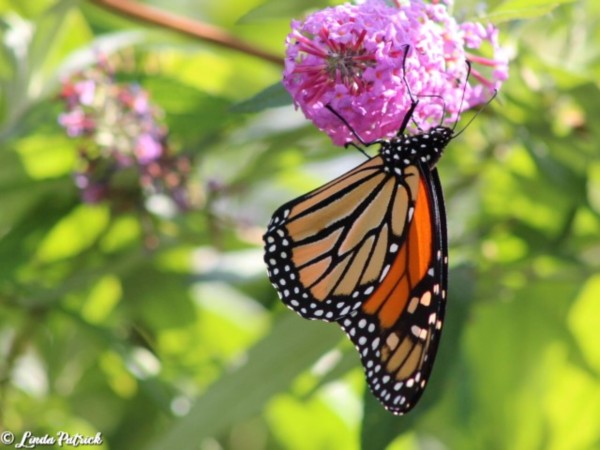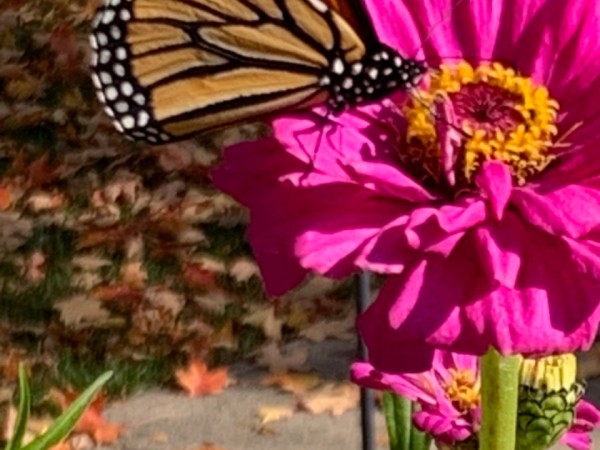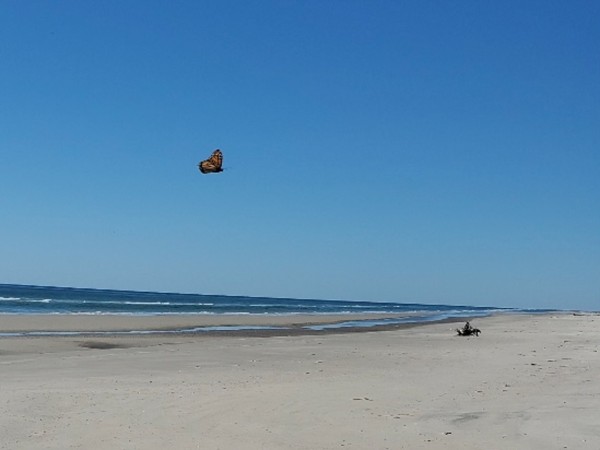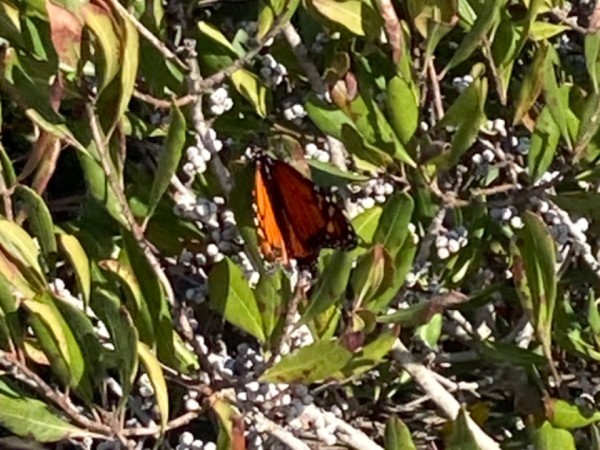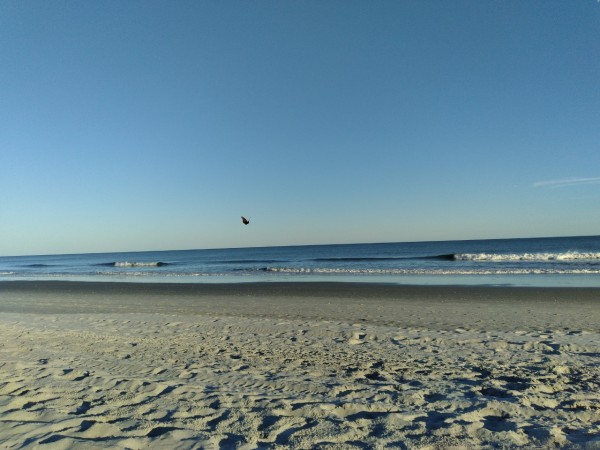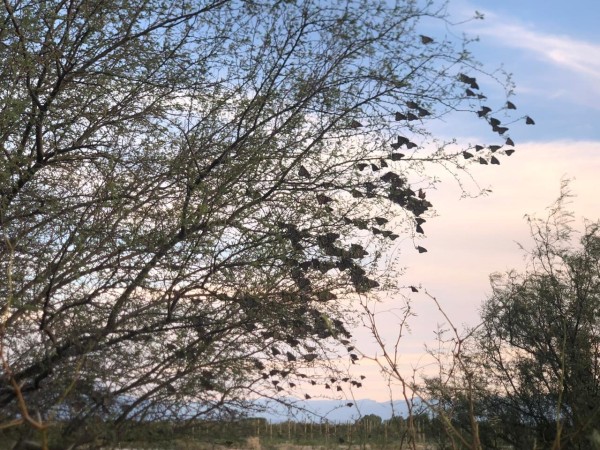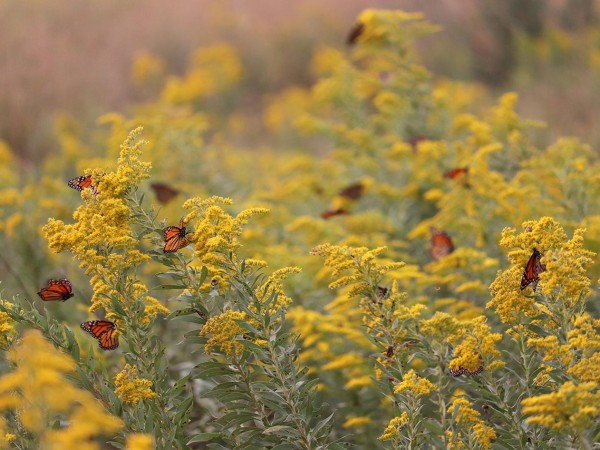Eastern Monarch Population Fall 2023 News Update: Report #5
published: 10/25/2023
Central Flyway: Monarchs Persist
Unseasonably warm temperatures have allowed monarchs to persist as far north as Canada and throughout the central flyway. Fall roosts are now reported along the Gulf Coast.
Linda in Chatham, ON, Canada: "This is the first monarch we've had since Oct 13th. After a light frost yesterday a:m, it got up to a sunny 21C here today. This male arrived about 1:30 p:m and stayed feeding at bushes until about 3:30 p:m. He could still be here in the trees somewhere as I didn't see him leave. The winds were SSW @20 km/hr. Waystation #13039." (10/24/2023)
Deb in Coldwater, MI, US saw one monarch nectaring on late blooming flowers.
Brian in Point Clear, AL: "Counted approximately 575 on the grounds of the Grand Hotel Marriott, mostly in bottlebrush around the pool area. It appears peak migration has finally come in (30 last weekend, 150 on Friday, 575 today). Lots of interest by patrons and staff." (10/22/2023)
Brigid in Matagorda Island, off coast of TX, US: "This is just one of over 100 monarchs that were streaming southwest down the Gulf beach of Matagorda Island." (10/17/2023)
Eastern Flyway: Slow Season
Volunteer reports from the Atlantic coastal states suggest that this year's fall migration season has been proceeding at a slower pace.
Kathleen in Cape May, NJ, US: "Very disappointing reporting on the fall migration. Arrived at dawn temperatures in the low 60s. Windy but sunny. Compared to previous years it was extremely sad to witness only a few Monarchs." (10/15/2023)
Susan in Myrtle Beach, SC, US: Counted 52 monarchs (over about a 3 hr time span)flying south down the beach on 10/22/2023 in Myrtle Beach, SC. There were about twice as many (if not more) Gulf fritillaries and a few Yellow Sulfur butterflies. The Gulf fritillaries were smaller than the monarchs and flapped their wings more. Most butterflies were flying solo, but a few were traveling in pairs. Earlier in the week we'd only see about 15 monarchs per day, but today was much warmer on the beach...which is probably why there were more monarchs." (10/22/2023)
Fall migration reporting along the Appalachian Mountains and Great Smokies seems to have peaked. Keep reporting if you are seeing monarchs.
Debbie in Pineville, KY, US: "Saw 8 monarchs traveling across Pine Mountain (KY) lookout at Debbie Hogg memorial within 5 minutes. They definitely are migrating on their way to MX." (10/19/2023)
From Programa Correo Real, PROFAUNA A.C.
Roosts are now reported in northern Mexico. Peak migration in Mexico is picking up.
"Estimados amigos: Desde hace tres días empezaron a llegar reportes de perchas de docenas de monarcas desde el municipio de Sabinas y más al sur hasta la ciudad de Saltillo y alrededores, lo mismo en el área metropolitana de Monterrey. La noche del sábado aumentó a cientos y miles la cantidad de monarcas que reportaban y, hoy desde muy temprano Saltillo se cubrió de mariposas cruzando la ciudad hacia el sureste, hace ya varios años que no las veíamos pasar en grandes cantidades. Los observadores del Correo Real están ya reportando a las primeras monarcas en Tamaulipas cerca del mar y la Laguna Madre, también recibimos reporte de 5 monarcas observadas en Jalpan de Serra Qro. y en Guanajuato en el municipio de Acámbaro y la primera en la Sierra de los Agustinos, ya muy cerca de sus sitios de hibernación. Así que estén muy atentos en los estados que quedan en la ruta migratoria, les recomendamos observar el cielo en cuanto amanezca, vuelan desde la altura de las casas pero también altísimo o al atardecer buscar las perchas de pernocta."
[English Google Translation: "Dear Friends, Three days ago, reports of perches of dozens of monarchs began to arrive from the municipality of Sabinas and further south to the city of Saltillo and surrounding areas, as well as in the metropolitan area of Monterrey. On Saturday night, the number of monarchs reported increased to hundreds and thousands, and, today from very early in the morning Saltillo was covered with butterflies crossing the city to the southeast, it has been several years since we saw them pass in large numbers. Observers from the Royal Post Office are already reporting the first monarchs in Tamaulipas near the sea and the Laguna Madre, we also received reports of 5 monarchs observed in Jalpan de Serra Qro. and in Guanajuato in the municipality of Acámbaro and the first in the Sierra de los Agustinos, very close to their hibernation sites. So be very attentive in the states that are on the migratory route, we recommend you to observe the sky as soon as dawn, fly from the height of the houses but also very high, or at sunset look for the perches for overnight stays."]
Check out their social media channels to catch more news from Correo Real, Profauna.
Report to Journey North
If you are seeing peak movement of monarchs, roosts, or the presence of monarchs at any life stage, please let us know. Your reports are crucial to our understanding of monarch migration.

